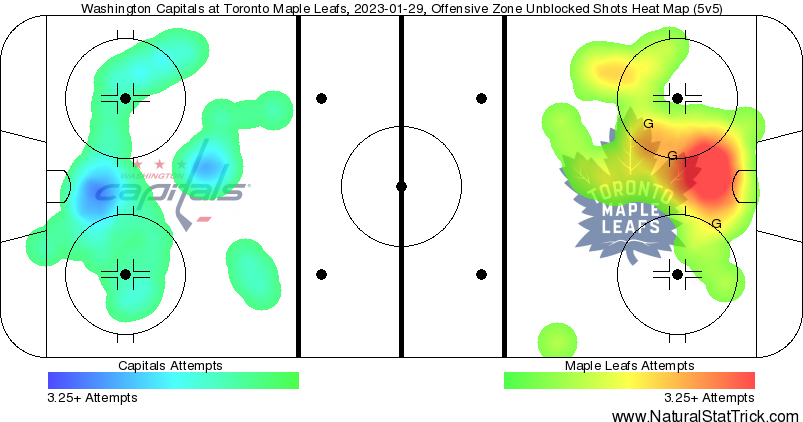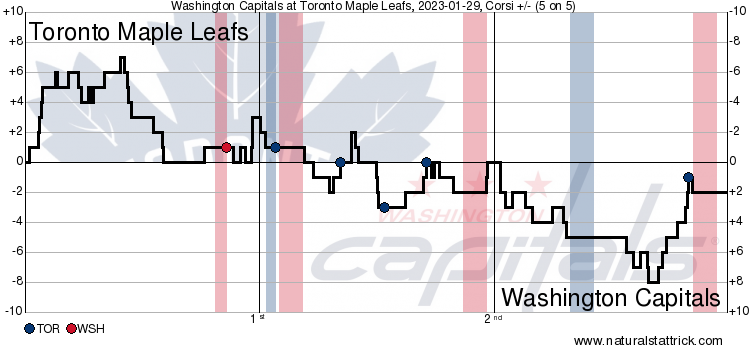The Maple Leafs received contributions from their power play and all four lines at five-on-five in a complete team win over the Washington Capitals on Sunday evening.
Your game in 10:
1. The biggest thing you’re looking for in this game is a really committed and high-energy effort from the Leafs given the circumstances. It is an important night to show up for their captain in his 1,000th game. Additionally, the game turned ugly on home ice versus Ottawa on Friday night, precipitating a quick players meeting afterward to make sure it did not become anything more than a one-off blip on the radar.
The Leafs didn’t generate enough quality scoring chances in the first period — Joey Anderson missed a gimme right at the end of the period, and there were a few other decent chances (two for Calle Järnkrok) — but it was obvious to me there was a pep in their step and no passengers on board tonight.
It was good to see. I am sure it’s not even a thought that has crossed the players’ minds all this time later, but it bugged me — enough that I clearly still haven’t forgotten about it — how badly the team played in John Tavares‘ first game back on Long Island after he signed in Toronto (a brutal 6-1 loss).
These games can be the telling ones as to the togetherness in the room and the ability to recognize the important moments within a season — i.e. the times when there is a need to elevate the collective commitment level. The Leafs passed the test with flying colours tonight.
2. Washington actually opened the scoring, though, late in the first period on the power play courtesy of a Nicklas Backstrom snipe off of the half wall after an Alex Kerfoot tripping penalty.
I am not sure if Mark Giordano was sizing up Backstrom knowing the Swede typically hurts you with his ability to exploit seams with his passing ability more than he does with his shot, but he could’ve afforded to flex out more toward the shooter than he did. Nonetheless, it was a perfect shot.
3. The Leafs answered with a power-play goal of their own early in the second period courtesy of Michael Bunting.
MIKEY B WITH THE PPG!! pic.twitter.com/cc8RNNxAa5
— Toronto Maple Leafs (@MapleLeafs) January 29, 2023
After the loss to the Senators, I wrote the following about the Leafs‘ power play without Matthews:
There was something nice and simple about the [Nylander] power-play goal, and we arguably do not see the Leafs score enough of these on the power play by utilizing Tavares’ strengths down low, getting numbers down there, and forcing an ugly one over the line.
Overall, the power play did not look like it was out of ideas without Matthews; in fact, it actually seemed to have a pretty good amount of purpose to its approach.
With Matthews, Nylander, and Marner on the top unit, the Leafs often are in a position where they’re sort of interchanging the roles a lot on half walls. It can be very dynamic and fantastic for keeping the opponents guessing at times; at other times, you wonder if it falls into the tendency of spending time shifting around on the perimeter taking up different positions, feeling as though there is dynamic movement happening when it’s actually kind of static in terms of getting pucks into the middle or funneled down toward the net.
This current setup has Michael Bunting at the net front, John Tavares in the bumper spot, Morgan Rielly up top, and Mitch Marner and William Nylander on the half walls. Of course, they will miss the commanding presence of Matthews and his ability to beat a goalie from anywhere at any time, but there is still more than enough elite scoring talent on the ice among this group, and the roles are clearly defined with everyone slotted in their most “natural” position throughout.
A long sample of this PP unit sans Matthews would obviously never outperform a PP unit with Matthews on it, but maybe it creates a bit of a jolt that provides some lessons and highlights a few different ways to score goals, benefitting the group in the long run.
Tonight, the Leafs scored another goal where they simply funneled the puck into John Tavares and Michael Bunting for a tip and a jam play over the goal line, although this one actually came after Mitch Marner danced around the top of the zone to create the lane.
Sheldon Keefe mentioned a few weeks ago that one benefit that could emerge out of the five-forward power-play experiment is that it could give Marner some added confidence and comfortability when he’s rotating up high and surveying the ice from up top. It certainly looked to be the case on this goal. The five-forward look also gave Bunting some extra time at the net front with the top unit, and he seems to be meshing in nicely on the 4F+1D setup without Matthews so far.
4. TJ Brodie didn’t directly have a hand in the goal, but there was something fitting about Morgan Rielly bumping his scoring slump — dating back 35 games to Game 7 vs. Tampa — as soon as he re-united with Brodie tonight.
Rielly gave the Leafs the 2-1 lead (which stood up as the game-winner) seven minutes into the second period when the Capitals ended up with four below the goal line and one cheating out of the zone. Tavares and Bunting came up with the puck below the goal line, and Rielly read it well to identify the opportunity developing, finishing the play off into the top corner while wide open in front.
Mo 𝘙𝘪𝘦𝘭𝘭𝘺 loves cheddar 🧀 pic.twitter.com/NBchjIZjgx
— Toronto Maple Leafs (@MapleLeafs) January 29, 2023
We’ve all seen the stats about the goal and point production from the Leafs’ blue line as compared to the rest of the league. A confident Rielly is hugely important to the team’s secondary scoring credibility beyond the big four up front.
An important goal for Rielly, the team, and the result tonight.
5. It was instantly obvious in this game that the Leafs were exiting the zone quicker and cleaner — thanks in part to the return of TJ Brodie and his individual play in the game, but especially because of the trickle-down effect his presence creates in the form of three defense pairs that gel together (good communication and awareness of where the partner is on the ice, clean D-to-D plays under pressure, etc).
The Capitals are a physical forechecking team; they threw 70 hits combined in the first two games against the Leafs and were credited with 40 more tonight. We saw times when TJ Oshie, Alex Ovechkin, and company were starting to run around on the Leafs a little. But the Caps weren’t able to get on top of the Leafs with their forecheck all that often in the game thanks to how quickly the Leafs played on defense and the efficiency with which they exited the zone. The Leafs are a faster team than the aging Capitals when they execute, and it showed in the second period especially.
In the last week on home ice, the Leafs faced a team in the Islanders that attempted to trap them and another in the Capitals that tried to push them a little physically, and despite falling behind 1-0 both times, they passed those tests by dominating with four-goal second periods.
Funny enough, on one occasion when the Capitals’ forecheck did get on top of the Leafs for a spell in the second period, it led to Toronto’s 3-1 goal on a counterattack three-on-one opportunity.
6. On the three-on-one opportunity for the Leafs — an all-Swede affair with Rasmus Sandin, William Nylander, and Calle Järnkrok — the Leafs actually overpassed it initially and ran themselves out of room. They redeemed themselves by stopping at the net rather than skating past it. That allowed Nylander to collect a second opportunity and bury the 3-1 goal.
A Swede Toronto trifecta 🇸🇪 pic.twitter.com/7gIyEkfPCc
— Toronto Maple Leafs (@MapleLeafs) January 29, 2023
7. The 45-goal pace continues for William Nylander, who is an All-Star in a world where All-Star honours meant something and the NHL didn’t approach the ASG as though it didn’t want to hurt any team’s feelings.
At game #51, Nylander is now just six shy of last season’s goal total (34) in 30 fewer games. Lately, he’s picking up a lot of the dirty ones at the net to go along with the usual Nylander snipes.
He also led the team tonight with over 90% of the expected goals and over 70% of the shot attempts when he was on the ice. It’s not just the production — going from 35-goal, 75-80-point territory into 40+ goal, 90+ point territory — but he is also hitting another level of consistency as a dominant five-on-five play-driver game after game.
This changes the feel of the team. In years past, the Leafs have looked like a club with two high-end first lines on paper (which is what they’re constructed to be), but it hasn’t always felt that way in reality at five-on-five. It does right now (when Matthews is healthy, of course).
8. With the 4-1 goal, Pierre Engvall now has eight goals in his last 26 games playing primarily with David Kampf as his center, which is pretty good production after his slow start to the season that led to a couple of healthy scratches.
🎯 BEAUT BY BISCUIT 🎯 pic.twitter.com/bQBiW04p80
— Toronto Maple Leafs (@MapleLeafs) January 29, 2023
Especially since his impressive end-to-end goal against Boston, there is more intention to Engvall’s puck touches. He seems to be using his legs to open space/a lane and then confidently firing it on net versus the aimless curling and circling he can fall into at times. His shot is definitely underrated, but he hasn’t always used it as much as he should (or at the right times).
Overall, Engvall is on pace for 17 goals, which is actually up from last season’s career-high total of 15 if it holds. The Leafs really need another player in their bottom six who is a credible 20-goal threat outside of Engvall, but credit to him for being the main driver of the team’s offense down there of late.
9. Overall, the Leafs saw out the win with little drama in the third period. They spent quite a bit of time inside their zone in the first 10-15 minutes, but they didn’t give up much of anything inside the house, protected Ilya Samsonov well, and then picked their spots for some dangerous offensive forays.
The bottom six chipped in another goal in garbage time courtesy of Zach Aston-Reese on a breakaway after a good pass from Pontus Holmberg, but this goal was entirely set up by a big-time shift from the third line.
Let's take a minute to appreciate Reeser's slick tuck 🤌 pic.twitter.com/Yt0Jcjmkft
— Toronto Maple Leafs (@MapleLeafs) January 30, 2023
Pierre Engvall – David Kampf – Joey Anderson broke Washington’s remaining will with a really long cycle shift in the offensive zone, killing a bunch of clock 200 feet from the Leaf net and exhausting the Caps’ skaters, who were dragging their heavy legs back to the bench as Mark Giordano made a quick-up play to Holmberg.
It actually could’ve been an even more productive night on the scoresheet than it was for the bottom six. David Kampf and Joey Anderson both missed empty nets, and Anderson had another grade-A chance he didn’t cash in on.
10. Congrats to JT on the silver stick. Amazing accomplishment.



































![New Leaf Anthony Stolarz on the opportunity in Toronto: “In Florida, I knew my role as a backup… Now, [Joseph Woll] and I are competing for starts… As a goalie, that’s all you can ask for” Anthony Stolarz, Stanley Cup win, now Maple Leaf](https://mapleleafshotstove.com/wp-content/uploads/2024/07/anthony-stolarz-sc-100x70.jpg)
